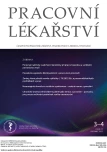Assessment of exposure to diisocyanates in the work environment
Authors:
P. Matejíčeková; M. Kizeková; M. Matejová; Ľ. Legáth
Authors‘ workplace:
Klinika pracovného lekárstva a klinickej toxikológie UPJŠ a UNLP v Košiciach, prednosta prof. MUDr. Ľubomír Legáth, PhD.
Published in:
Pracov. Lék., 74, 2022, No. 3-4, s. 51-56.
Category:
Review Papers
Overview
Exposure to diisocyanates is associated with the development and increased risk of occupational respiratory diseases – allergic rhinitis, bronchial asthma and hypersensitivity pneumonitis. The assessment of exposure to isocyanates in the work environment is based on the measurement of their concentration in the air. In addition to this method, biological monitoring is also used to assess occupational exposure to isocyanates. This process is based on the determination of concentration of isocyanate metabolism products in biological material, mostly corresponding diamines in urine. Several foreign studies have investigated the correlation between the results of isocyanates monitoring in work environment and biological monitoring. The results of the studies show that workers are exposed to isocyanates by inhalation as well as by the dermal route. The results also indicate that the analysis of diamines in biological material is suitable method for assessing overall exposure, which includes all exposure pathways and could contribute to reducing the level of exposure to isocyanates in the workplace.
Keywords:
diisocyanates – professional exposure – biological monitoring
Sources
1. Lockey, J. E., Redlich, C. A., Streicher, R., et al. Isocyanates and Human Health. Journal of Occupational & Environmental Medicine, 2015, 57, 1, s. 44–51.
2. Verschoor, L., Verschoor, A. H. Nonoccupational and occupational exposure to isocyanates. Current Opinion in Pulmonary Medicine, 2014, 20, 2, s. 199–204.
3. Henneken, H., Vogel, M., Karst U. Determination of airborne isocyanates. Analytical and Bioanalytical Chemistry, 2007, 387, 1, s. 219–236.
4. Rother, D., Schlüter, U. Occupational Exposure to Diisocyanates in the European Union. Annals of Work Exposures and Health, 2021, 65, 8, s. 893–907.
5. Scholten, B., Kenny, L., Duca, R. C., et al. Biomonitoring for Occupational Exposure to Diisocyanates: A Systematic Review. Annals of Work Exposures and Health, 2020, 64, 6, s. 569–585.
6. Matejíčeková, P. Monitorovanie expozície izokyanátom u zamestnancov vybraných odvetví [dizertačná práca]. Košice: Univerzita Pavla Jozefa Šafárika, 2022. 94 s.
7. Wenk, K. S., Ehrlich, A. Isocyanates. Dermatitis, 2012, 23, 3, s. 130–131.
8. Spence, M. W., Plehiers, P. M. A brief overview of properties and reactions of diisocyanates. Toxicology and Industrial Health, 2022, 38, 9, s. 495–499.
9. Jones, F. N., Nichols, M. E., Pappas, S. P. Polyurethanes and Polyisocyanates. In: Organic Coatings: Science and technology, Fourth Edition [online]. USA: John Wiley & Sons, 2017, s. 163 – 188.
10. Nariadenie vlády SR č. 300/2007 Z. z., ktorým sa mení nariadenie vlády Slovenskej republiky č. 355/2006 Z. z. o ochrane zamestnancov pred rizikami súvisiacimi s expozíciou chemickým faktorom pri práci.
11. Levine, S. P. Critical Review of Methods for Sampling, Analysis, and Monitoring of Vapor-Phase Toluene Diisocyanate. Applied Occupational and Environmental Hygiene, 2010, 17, 12, s. 878 – 890.
12. Schupp, T., Plehiers, P. M. Absorption, distribution, metabolism, and excretion of methylene diphenyl diisocyanate and toluene diisocyanate: Many similarities and few differences. Toxicology and Industrial Health, 2022, 38, 9, s. 500–528.
13. Cocker, J. Biological Monitoring for Isocyanates. The Annals of Occupational Hygiene, 2011, 55, 2, s. 127–131.
14. Pronk, A., Yu, F., Vlaanderen, J., et al. Dermal, inhalation, and internal exposure to 1,6-HDI and its oligomers in car body repair shop workers and industrial spray painters. Occupational and Environmental Medicine, 2006, 63, 9, s. 624–631.
15. Jones, K., Cocker, J., Piney, M. Isocyanate exposure control in motor vehicle paint spraying: evidence from biological monitoring. The Annals of Occupational Hygiene, 2013, 57, 2, s. 200 – 209.
16. Flack, S. L., Fent, K. W., Gaines, L. G. T. et al. Quantitative plasma biomarker analysis in HDI exposure assessment. The Annals of Occupational Hygiene, 2010, 54, 1, s. 41–54.
17. Flack, S. L., Fent, K. W., Gaines L. G. T. et al. Hemoglobin adducts in workers exposed to 1,6-hexamethylene diisocyanate. Biomarkers, 2011, 16, 3, s. 261–270.
18. Świerczyńska-Machura, D., Brzeźnicki, S., Nowakowska-Świrta, E. et al. Occupational exposure to diisocyanates in polyurethane foam factory workers. International Journal of Occupational Medicine and Environmental Health, 2015, 28, 6, s. 985–998.
19. Geens, T., Dugardin, S., Schockaert, A. et al. Air exposure assessment of TDI and biological monitoring of TDA in urine in workers in polyurethane foam industry. Occupational and Environmental Medicine, 2012, 69, 2, s. 93–98.
20. Littorin, M., Rylander, L., Skarping, G. et al. Exposure biomarkers and risk from gluing and heating of polyurethane: a cross sectional study of respiratory symptoms. Occupational and Environmental Medicine, 2000, 57, 6, s. 396–405.
21. Sabbioni, G., Wesp, H., Lewalter, J. et al. Determination of isocyanate biomarkers in construction site workers. Biomarkers, 2007, 12, 5, s. 468–483.
22. Sabbioni, G., Dongari, N., Kumar, A. Determination of a new biomarker in subjects exposed to 4,4'-methylenediphenyl diisocyanate. Biomarkers, 2010, 15, 6, s. 508–515.
23. Henriks-Eckerman, M. L., Mäkelä, E. A., Laitinen, J. et al. Role of dermal exposure in systemic intake of methylenediphenyl diisocyanate (MDI) among construction and boat building workers. Toxicology Letters, 2015, 232, 3, s. 595–600.
Labels
Hygiene and epidemiology Hyperbaric medicine Occupational medicineArticle was published in
Occupational Medicine

2022 Issue 3-4
Most read in this issue
- Assessment of exposure to diisocyanates in the work environment
- Changes brought by the amendment to Decree 79/2022 Coll. on occupational medical examinations in practice
- Comparison of upper extremity muscle activity when working with a classic and vertical computer mouse
- prof. MUDr. Zdeněk Jirák, CSc.
